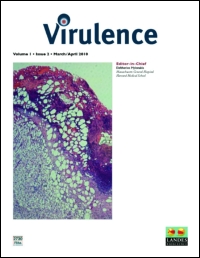Ver ítem
- xmlui.general.dspace_homeCentros e Institutos de InvestigaciónCICVyA. Centro de Investigación en Ciencias Veterinarias y AgronómicasInstituto de BiotecnologíaArtículos científicosxmlui.ArtifactBrowser.ItemViewer.trail
- Inicio
- Centros e Institutos de Investigación
- CICVyA. Centro de Investigación en Ciencias Veterinarias y Agronómicas
- Instituto de Biotecnología
- Artículos científicos
- Ver ítem
Virulence factors of the Mycobacterium tuberculosis complex
Resumen
The Mycobacterium tuberculosis complex (MTBC) consists of closely related species that cause tuberculosis in both humans and animals. This illness, still today, remains to be one of the leading causes of morbidity and mortality throughout the world. The mycobacteria enter the host by air, and, once in the lungs, are phagocytated by macrophages. This may lead to the rapid elimination of the bacillus or to the triggering of an active tuberculosis infection.
[ver mas...]
The Mycobacterium tuberculosis complex (MTBC) consists of closely related species that cause tuberculosis in both humans and animals. This illness, still today, remains to be one of the leading causes of morbidity and mortality throughout the world. The mycobacteria enter the host by air, and, once in the lungs, are phagocytated by macrophages. This may lead to the rapid elimination of the bacillus or to the triggering of an active tuberculosis infection. A large number of different virulence factors have evolved in MTBC members as a response to the host immune reaction. The aim of this review is to describe the bacterial genes/proteins that are essential for the virulence of MTBC species, and that have been demonstrated in an in vivo model of infection. Knowledge of MTBC virulence factors is essential for the development of new vaccines and drugs to help manage the disease toward an increasingly more tuberculosis-free world.
[Cerrar]

Fuente
Virulence 4 (1) : 3-66 (2013)
Fecha
2013-01
Editorial
Taylor & Francis
ISSN
2150-5594
2150-5608
2150-5608
Formato
pdf
Tipo de documento
artículo
Palabras Claves
Derechos de acceso
Abierto
 Excepto donde se diga explicitamente, este item se publica bajo la siguiente descripción: Creative Commons Attribution-NonCommercial-ShareAlike 2.5 Unported (CC BY-NC-SA 2.5)
Excepto donde se diga explicitamente, este item se publica bajo la siguiente descripción: Creative Commons Attribution-NonCommercial-ShareAlike 2.5 Unported (CC BY-NC-SA 2.5)


